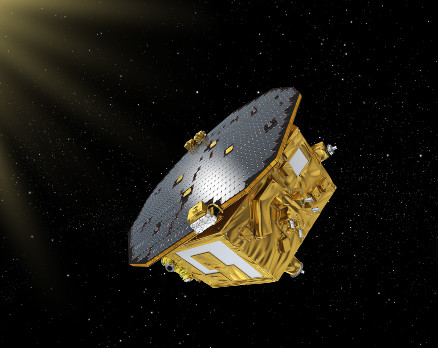{lang en}
ESA’s LISA Pathfinder lifted off earlier today on a Vega rocket from Europe’s spaceport in Kourou, French Guiana, on its way to demonstrate technology for observing gravitational waves from space. Gravitational waves are ripples in the fabric of spacetime, predicted a century ago by Albert Einstein’s General Theory of Relativity, published on 2 December 1915.

{/lang}
{lang nl} De Europese ruimtesonde LISA Pathfinder (ESA) is vanochtend vroeg met succes gelanceerd vanaf de lanceerbasis Kourou, Frans-Guyana. De ruimtesonde werd vervolgens in een baan om de aarde gebracht, waarna hij koers zette naar zijn definitieve positie in de ruimte. De sonde moet technologie testen voor het meten van zwaartekrachtsgolven in de ruimte.

{/lang}
{lang en}
The Vega launcher lifted off at 04:04 GMT (05:04 CET). About seven minutes later, after separation of the first three stages, the first ignition of Vega’s upper stage propelled LISA Pathfinder into a low orbit, followed by another ignition about one hour and forty minutes into the flight.
The spacecraft separated from the upper stage at 05:49 GMT (06:49 CET). Controllers at ESA’s operations centre in Darmstadt, Germany then established control. Over the next two weeks, the spacecraft itself will raise the orbit’s highest point in six critical burns.The final burn will propel the spacecraft towards its operational location, orbiting around a stable virtual point in space called L1, some 1.5 million kilometres from Earth towards the Sun.
LISA Pathfinder is expected to reach its operational orbit about 10 weeks after launch, in mid-February. After final checks, it will begin its six-month scientific mission at the beginning of March.
Einstein
Einstein’s theory predicts that gravitational waves should be universal, generated by accelerating massive objects. However, they have not been directly detected to date because they are so tiny. For example, the ripples emitted by a pair of orbiting black holes would stretch a million kilometre-long ruler by less than the size of an atom.
LISA Pathfinder will test the extraordinary technology needed to observe gravitational waves from space. At its core is a pair of identical 46 mm gold-platinum cubes separated by 38 cm, which will be isolated from all external and internal forces acting on them except one: gravity.
The mission will put these cubes in the purest free-fall ever produced in space and monitor their relative positions to astonishing precision, laying the foundations for gravitational wave observatories in space.
Such future missions will be key partners to the ground sites already searching for these elusive cosmic messengers. Space and ground experiments are sensitive to different sources of gravitational waves, both opening up new possibilities to study some of the most powerful phenomena in the Universe.
{/lang} {lang nl}
ISA Pathfinder werd rond 5 uur vanochtend op een Vega-raket gelanceerd. Ongeveer zeven minuten later, nadat de eerste drie trappen van de raket waren afgestoten, bracht de raket LISA Pathfinder in een lage baan om de aarde. Om 6.49 uur maakte de ruimtesonde zich los van de laatste trap van de raket, waarna de vluchtleiding in Darmstadt de besturing overnam.
De komende twee weken bereikt de sonde stapsgewijs het hoogste punt van zijn baan om de aarde, om daarna koers te zetten naar Lagrangepunt 1, een relatief stabiele positie op 1,5 miljoen km van de aarde. De Europese ruimtevaartorganisatie ESA verwacht dat LISA Pathfinder daar in het midden van februari 2016 aankomt. Na een aantal laatste tests begint Pathfinder dan begin maart aan zijn wetenschappelijke programma, dat een half jaar zal duren.
LISA Pathfinder gaat de precisietechnologie testen die nodig is om zwaartekrachtsgolven vanuit de ruimte te meten. Daarmee legt de ruimtesonde de technologische basis voor de Europese eLISA-missie (ESA), die rond circa 2034 de ruimte in gaat.
Nederland
Nederlandse ingenieurs en wetenschappers zijn nauw betrokken bij het internationale onderzoek naar zwaartekrachtsgolven, zowel via experimenten op de grond als via ruimtemissies. O.a. ruimteonderzoeksinstituut SRON, de Radboud Universiteit, Nikhef, TNO, NOVA, Universiteit Twente, Universiteit van Amsterdam, Universiteit Leiden, Rijksuniversiteit Groningen en de Vrije Universiteit leveren belangrijke bijdragen.{/lang}


